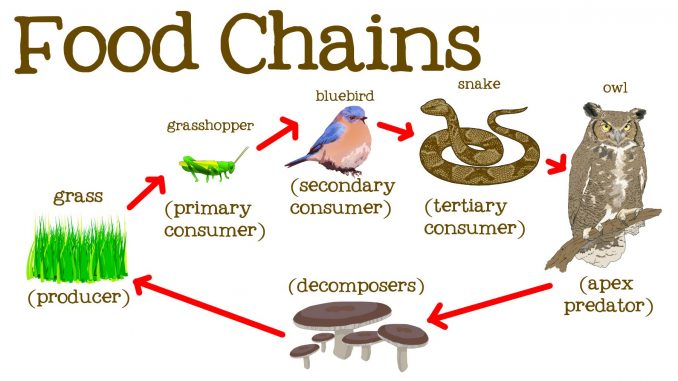
Food chain, trophic levels and flow of energy in ecosystem
Food chain:
- Transfer of food from one trophic level to another through series of organisms with repeated eating and being eaten is called a food chain.
- Food chain is the linear unidirectional flow of energy and materials through the food from one trophic level to the other.
- In a food chain, each stage represents a trophic level.
A food chain consists of following trophic levels.
- Producers
- consumers
- Primary consumers
- Secondary consumers
- Tertiary consumers
- Decomposers
Trophic levels:
- The feeding levels from producers to consumers is called trophic level. The energy flows only one way through various trophic levels.
- First trophic level- Producers – Autotrops
- Second trophic level – Primary consumers – Herbivores
- Third trophic level – Secondary consumers – Carnivores
- Fourth trophic level – Tertiary consumers – Top level carnivorous
1. Producers:
- They are autotrophs and represent 1st trophic level which can synthesize the food using light energy.
- They produces food for all other organisms of ecosystem.
- They are largely green plants and photosynthetic prokaryotes which converts inorganic substrate into organic food by the process of photosynthesis.
- The rate at which the radiation energy is stored by the process of photosynthesis in the green plant is called gross primary productivity (GPP).
2.Consumers:
- They are heterotrophs which obtain energy from producers directly or indirectly. They can be further divided as
i. Primary consumers:
- They are animals which feeds directly on plants.
- They are 1st level consumers and therefore they are known as primary consumers.
- Primary consumers make the II trophic level in food chain.
- Examples: herbivores animals such as deer, goat, cow etc.
ii. Secondary consumers:
- These are animals that feeds on other animals.
- They are omnivores and carnivores. Eg Bear, wolf, jackel, and snake etc.
iii. Tertiary consumers:
- These animals get their food from all consumers.
- They are top carnivores. Eg lion, tiger, and eagle etc.
3. Decomposers:
- They feed on dead and decayed plants or animals.
- They make up the final trophic level in food chain.
- They decompose the dead and decay matter and helps in recycling the nutrients.
- They are classified into two class:
- Micro-decomposers: Bacteria, Fungi, Protozoa
- Macro-decomposers: Earth worm, Nematodes, Molluscals
Energy flow in ecosystem:
- The process of transfer of energy to various trophic level of food chain is known as flow of energy.
- Energy flow in ecosystem from energy source to autotrophs to heterotrophs.
- For most ecosystem the energy source is the sun and the autotrophs are the green plants and BGAs. The solar energy that is captured in as ecosystem is based on the amount of photosynthesis that occur there.
- The energy flow is best described by net primary productivity(NPP)= Gross primary productivity (GPP)- Respiration (Rp)
- NPP= GPP-Rp
- Secondary productivity is the amount of bio-mass produced by consumers. It is dependent on the amount of energy made available by primary producers and so on.
- The entire process of energy floe is summarized in following points;
- The flow of energy in an ecosystem is always linear ie uni direction
- At each energy step in food chain, the energy received by the organisms is used for its own metabolism and maintenance. The left over energy is passed to next higher trophic level. Thus the energy flow decreases with successive trophic level.
- Flow of energy follows the ecological rule of 10%.
